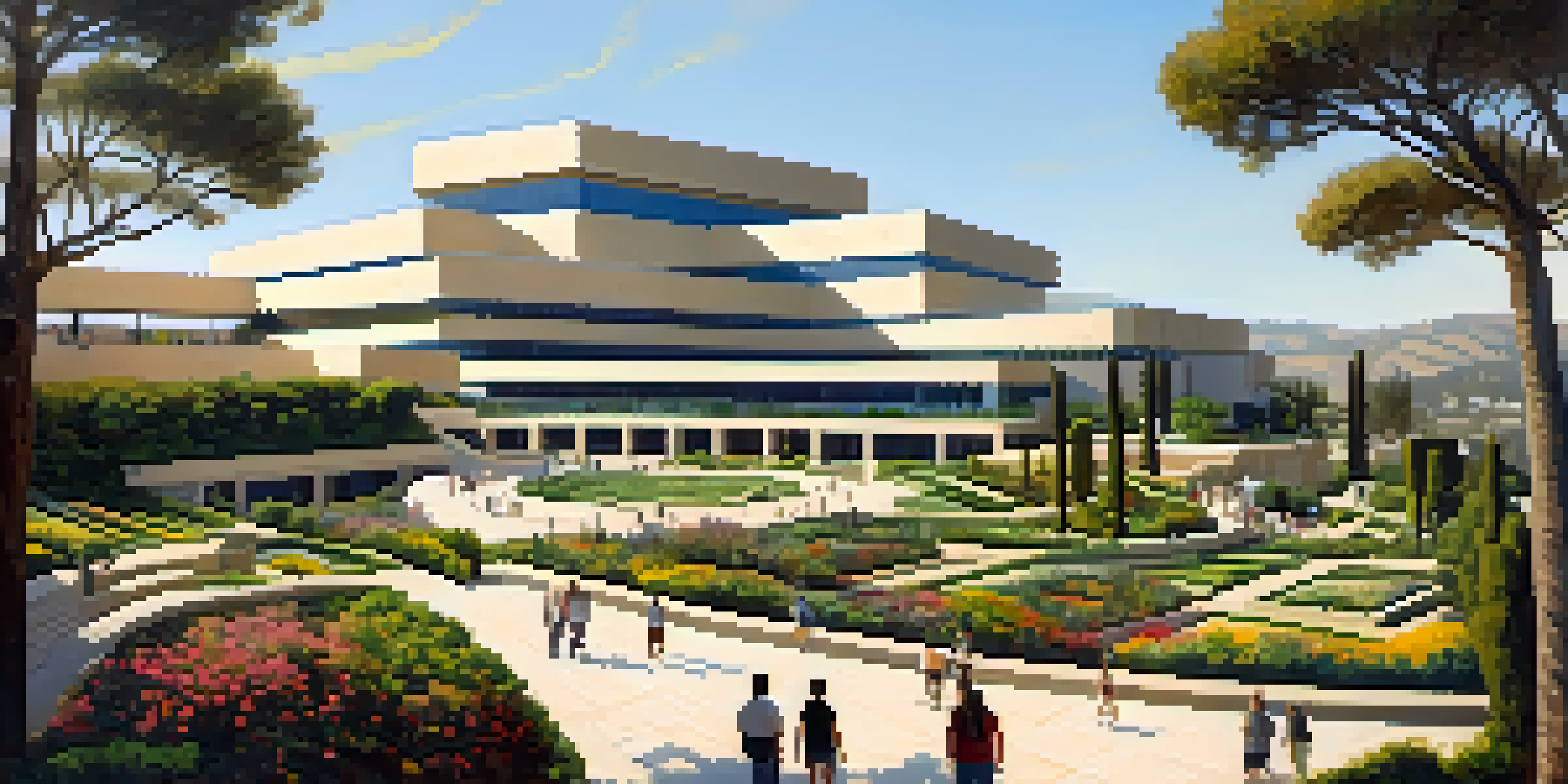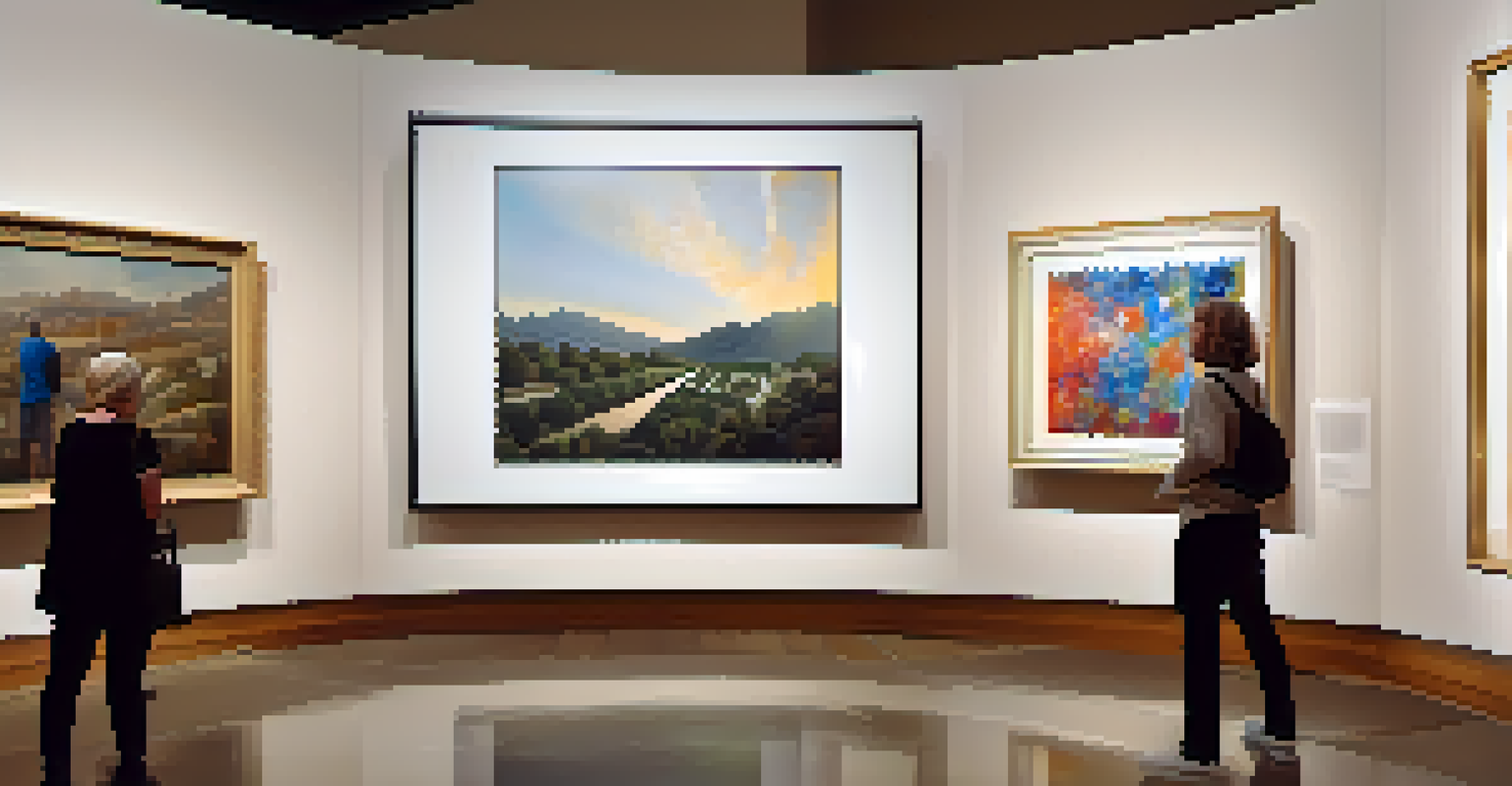Exploring the Impact of The Getty Center on LA's Cultural Scene

Introduction to The Getty Center and Its Vision
The Getty Center, perched in the hills of Los Angeles, is more than just a museum; it’s a cultural landmark. Opened in 1997, this architectural masterpiece was designed by Richard Meier and serves as a hub for art, education, and conservation. Its stunning gardens and panoramic views of the city invite visitors to explore a blend of nature and creativity.
Art is not what you see, but what you make others see.
The vision behind The Getty Center was to create a space where art could be appreciated and studied, providing access to exceptional collections of European paintings, sculptures, and decorative arts. With its commitment to education, The Getty also hosts workshops, lectures, and community programs that foster a deeper understanding of art.
By integrating art with the natural landscape, The Getty Center not only enhances the visitor experience but also sets a standard for cultural institutions. Its mission to promote the understanding and enjoyment of the visual arts has undoubtedly impacted Los Angeles's vibrant cultural scene.
Architectural Significance and Design
The Getty Center's architecture is a testament to modern design, marked by its intricate use of light and space. The building materials, primarily travertine, were sourced from the same Italian quarries as those used in ancient Roman structures, connecting the past with the present. This thoughtful design creates a unique atmosphere that draws visitors in and encourages exploration.

The layout of the center is designed to guide visitors through a journey of discovery, with each gallery seamlessly flowing into the next. This intentionality enhances the experience, making art accessible and inviting. The use of gardens and outdoor spaces further enriches the environment, allowing guests to engage with art in a tranquil setting.
Cultural Landmark in Los Angeles
The Getty Center serves as a vital cultural hub that blends art, education, and community engagement.
As a piece of art in itself, The Getty Center stands as a symbol of innovation in architectural design. Its impact extends beyond just aesthetics; it has redefined the visitor experience in cultural institutions across Los Angeles and beyond.
Cultural Programming and Community Engagement
One of the key ways The Getty Center influences LA's cultural scene is through its diverse programming. From art exhibitions to concerts and film screenings, the center offers a wide array of events that cater to various interests. These programs not only showcase local talent but also feature international artists, enriching the cultural fabric of the city.
The best way to predict the future is to create it.
The Getty’s commitment to community engagement is evident through its free admission policy and family-friendly activities. Special events, like the annual Getty 25th Anniversary celebration, invite the public to partake in art discussions and hands-on workshops, fostering a sense of belonging and appreciation for the arts.
By actively involving the community, The Getty Center promotes a culture of creativity and collaboration. This engagement helps demystify art, making it accessible to everyone, regardless of background or experience.
Educational Initiatives and Accessibility
Education is at the heart of The Getty Center's mission. The institution offers a variety of educational programs aimed at students of all ages, from K-12 to adult learners. These initiatives include guided tours, interactive workshops, and online resources that encourage deeper engagement with art and history.
The Getty's dedication to accessibility is commendable, ensuring that everyone can enjoy and learn from its collections. The center provides resources like audio guides, tactile experiences, and specialized programs for individuals with disabilities, making art more inclusive.
Architectural Masterpiece
Designed by Richard Meier, the Getty Center's innovative architecture and integration with nature enhance the visitor experience.
Through these educational efforts, The Getty Center plays a vital role in shaping the next generation of art enthusiasts and scholars. By fostering a love for art and learning, it contributes significantly to Los Angeles's cultural landscape.
The Getty's Role in Art Conservation
Art conservation is another crucial aspect of The Getty Center's impact. The institution is home to a world-renowned conservation institute that works tirelessly to preserve artistic heritage for future generations. This commitment to safeguarding art not only protects valuable pieces but also contributes to the broader field of conservation.
The Getty’s conservation efforts extend beyond its own collections; the center collaborates with museums and cultural institutions around the globe. These partnerships facilitate knowledge exchange and promote best practices in art preservation, benefiting the entire art community.
By prioritizing conservation, The Getty Center reinforces the importance of protecting our cultural heritage. This dedication enhances the city’s reputation as a leader in art preservation, further solidifying its cultural significance.
The Getty Center's Economic Impact on Los Angeles
Beyond cultural contributions, The Getty Center has a significant economic impact on Los Angeles. The influx of visitors, both local and international, stimulates the economy through tourism, dining, and retail. The center attracts millions of visitors each year, contributing to the financial vitality of the surrounding community.
Local businesses benefit from the traffic generated by the Getty, with many restaurants, shops, and hotels seeing increased patronage. This symbiotic relationship highlights how cultural institutions can drive economic growth while enriching the community's cultural offerings.
Economic Catalyst for the Community
The Getty Center boosts the local economy by attracting millions of visitors, benefiting surrounding businesses and enhancing cultural offerings.
In essence, The Getty Center serves as a catalyst for economic development, showcasing how art and culture can positively influence the local economy and enhance the overall quality of life in Los Angeles.
Conclusion: The Lasting Legacy of The Getty Center
As we explore the impact of The Getty Center on Los Angeles’s cultural scene, it’s clear that its influence is profound and far-reaching. From its stunning architecture to its dedication to education and community engagement, The Getty has redefined what it means to appreciate art. It stands not only as a museum but as a beacon of creativity and inspiration.
The legacy of The Getty Center continues to grow, attracting new audiences and fostering a deeper understanding of art. Its commitment to conservation and accessibility ensures that future generations will also have the opportunity to engage with and appreciate the arts.

In conclusion, The Getty Center is more than just a destination; it is a vital part of Los Angeles's cultural identity, leaving an indelible mark on the city and its residents. As we look to the future, it will undoubtedly continue to shape the artistic landscape of LA for years to come.